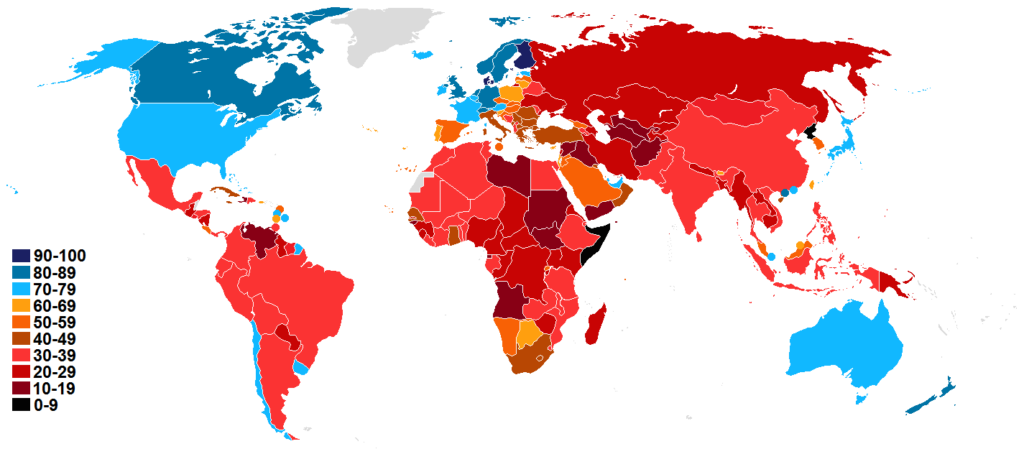Not all countries in the world are safe in terms of money payments. Time and again we hear about countries that are not “completely clean” in terms of money laundering and terrorist financing. Of course, these countries are bound by compliance rules when transferring money to banks in such countries. In our small series on this topic, we will show you how you can assess individual countries with regard to payments and how you can find out in your SAP system which countries your company transfers to with the help of SAP.
Who deals with the trustworthiness of individual countries?
There are several data sources to find out if countries are trustworthy or if payments to such countries could be a problem. There are also “black lists” on which countries can be listed. In connection with such a black list, the Financial Action Task Force (FATF) is of interest. The Financial Action Task Force (on Money Laundering) is the “Working Group on Anti-Money Laundering Measures” and is part of the OECD. The FATF publishes an annual report and assesses countries with regard to the problem of money laundering. Here you can see which countries were and are blacklisted.
If you want a more detailed assessment of countries, you could look at the Corruption Perception Index. The Corruption Perception Index (CPI) describes the perceived level of corruption in a state’s public sector. The Corruption Perception Index assigns a score to the different countries, which should express the extent to which corruption is perceived in the country or not.
Let’s take a look at the countries where there is little corruption (= high score).
| Rank | Country | Score |
|---|---|---|
| 1 | Denmark | 90 |
| 1 | New Zealand | 90 |
| 3 | Finland | 89 |
| 4 | Sweden | 88 |
| 5 | Switzerland | 86 |
| 6 | Norway | 85 |
| 7 | Singapore | 84 |
| 8 | Netherlands | 83 |
| 9 | Canada | 82 |
| 10 | Luxembourg | 81 |
| 10 | Germany | 81 |
After all, Germany is still among the top 10.
Of course, it is also interesting to see what the BAD 10 are, i. e. the countries with the highest level of perceived corruption.
| Rank | Country | Score |
|---|---|---|
| 166 | Iraq | 17 |
| 166 | Venezuela | 17 |
| 168 | Guinea-Bissau | 16 |
| 169 | Afghanistan | 15 |
| 170 | Yemen | 14 |
| 170 | Libya | 14 |
| 170 | Sudan | 14 |
| 174 | North Korea | 12 |
| 175 | Southern Sudan | 11 |
| 176 | Somalia | 10 |
Of course, there are also the “usual suspects” who also regard FATF as critical: Iran and North Korea.
The following map also provides a good overview:

Where can one find information about the trustworthiness of individual countries?
If you want to go even deeper into the matter, ask yourself where you can find the different criteria for assessing a country. The Corruption Perception Index 2016 uses 13 different sources for its investigation:
- African Development Bank Governance Ratings 2015
- Bertelsmann Foundation Sustainable Governance Indicators 2016
- Bertelsmann Foundation Transformation Index 2016
- Economist Intelligence Unit Country Risk Ratings 2016
- Freedom House Nations in Transit 2016
- Global Insight Country Risk Ratings 2015
- IMD World Competitiveness Yearbook 2016
- Political and Economic Risk Consultancy Asian Intelligence 2016
- Political Risk Services International Country Risk Guide 2016
- World Bank – Country Policy and Institutional Assessment 2015
- World Economic Forum Executive Opinion Survey (EOS) 2016
- World Justice Project Rule of Law Index 2016
- Varieties of Democracy (VDEM) Project 2016
Anyone who wants to lend a hand can take a look at the World Bank’s “Worldwide Governance Indicators” database. Various governance indicators can be called up for different countries over time.
In the next blog post, you will learn on how to find the countries you have transferred money to in SAP and can then link this information to the assessment of, for example, the Corruption Perception Index.
